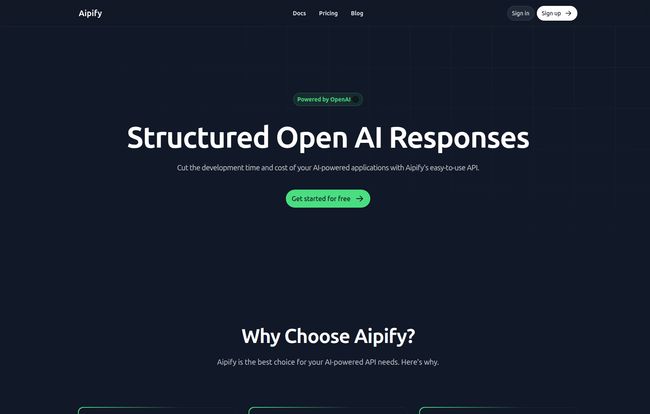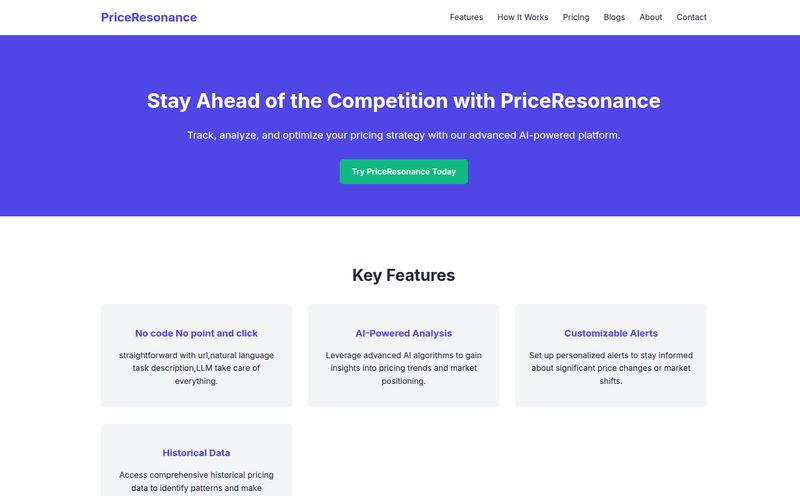As someone who lives and breathes SEO, traffic, and the tech that drives it, I've seen my fair share of tools promising to be the “next big thing.” Especially now, in this crazy AI gold rush, a new platform pops up every other Tuesday claiming it will revolutionize everything. Most of the time, it’s just hype.
But every now and then, something catches my eye that makes me sit up and lean a little closer to my screen. That’s what happened with Aipify. The promise is simple, almost deceptively so: build powerful, intelligent APIs using models like GPT-4, without writing a single line of code. My inner skeptic immediately raised an eyebrow, but my inner pragmatist—the one who's spent way too many nights wrestling with API documentation and parsing messy data—was intrigued.
So, is Aipify just another flash in the pan, or is it the tool that finally bridges the gap between powerful AI and practical application for the rest of us? I decided to find out.
What Exactly Is Aipify?
Think of Aipify as a universal translator and an assembly line all in one. On one side, you have these incredibly powerful but sometimes chaotic AI models from places like OpenAI. They're brilliant, but getting them to give you data in a clean, predictable way can be a chore. On the other side, you have your application, your website, or your workflow that needs that AI-generated data in a neat, orderly format.

Visit Aipify
Aipify sits in the middle. It lets you visually 'design' what you want the AI to do—like summarize text, analyze sentiment, or extract specific information. Then, it takes the AI’s response and packages it into a perfect, structured JSON format. It handles all the messy backend stuff, the server infrastructure, the security, and the scaling. You just get a clean, simple API endpoint to plug into your project. It's like having a master chef prepare a Michelin-star meal, and all you have to do is set the table.
The Core Features That Actually Matter
A platform is only as good as its features, but I’m not interested in a laundry list. I care about the stuff that actually saves time and headaches. Here's what stood out to me.
Visual API Design is a Game-Changer
This is the big one. The term “no-code” gets thrown around a lot, but here it really means something. Instead of writing Python scripts or cURL requests to test prompts, you're doing it all in a user-friendly interface. You can tell the AI, “I’ll give you a product review, and I want you to give me back a sentiment score from 1 to 10 and a one-sentence summary.” You define the inputs and outputs visually. For anyone who's not a hardcore developer, or even for developers who just want to move fast, this is huge. It turns a programming task into a simple configuration process.
Structured Responses: The Holy Grail of AI Integration
I cannot stress this enough. If you’ve ever worked directly with a language model, you know the output can be… creative. You ask for a list and sometimes you get a paragraph. You ask for a number and you get a full sentence explaining the number. It's a nightmare to parse reliably. Aipify forces the output into a predictable JSON structure. This means no more janky string manipulation or praying the AI formats its response correctly. You know that `response.sentiment_score` will always be there, and it will always be the data you expect. This feature alone probably cuts development time in half for any AI-related feature.
Tapping into Heavy Hitters like GPT-4
Getting direct access to top-tier models like GPT-4 can be a process. And managing your API keys, usage, and costs can be a job in itself. Aipify abstracts all that away. You get the power of the best models on the market through a simplified interface. It handles the secure connection, the token management, and provides a clear billing structure. You dont have to worry about a surprise bill from OpenAI because a script went haywire.
So, Who Is This Really For?
Initially, I thought this was just for non-coders. And it's definitely a fantastic tool for them. Marketers who want to auto-categorize customer feedback, founders building an MVP over a weekend, or content creators looking to automate summaries—they'll all love this.
But the more I look at it, the more I think it’s for developers too. It’s for the developer who’s been told, “Hey, can you add a little AI feature to our app by Friday?” Instead of spending a week on infrastructure, they can have a production-ready API endpoint in an hour. It’s for lean teams that value speed and iteration over building every single component from scratch. It’s a tool for pragmatists.
Let’s Talk Money: Aipify's Pricing Plans
Affordability is a huge factor, and Aipify's pricing model seems pretty reasonable. It's a classic tiered system that lets you grow into the platform.
- Free Plan ($0/month): This is your sandbox. You get 3 active APIs, a decent chunk of GPT-3.5 tokens, and a taste of GPT-4. It's perfect for testing ideas, personal projects, or very low-traffic applications. No reason not to try it.
- Starter Plan ($4.99/month): For less than a fancy coffee, you get unlimited APIs, way more tokens for both GPT-3.5 and GPT-4, and you can take your APIs 'live'. In my opinion, this is the sweet spot for most small businesses, freelancers, and serious side projects.
- Pro Plan ($24.99/month): This is for when you're scaling up. You get a massive number of tokens, which is ideal for applications with real user traffic or for running large-scale data processing tasks. The cost is still incredibly low compared to the developer hours it would take to build and maintain a similar system.
The Good, The Bad, and The AI-Dependent
No tool is perfect, right? It's always a series of trade-offs.
On the plus side, the speed and simplicity are undeniable. You can go from idea to functional AI-powered API in minutes. The structured data is a life-saver, and the managed infrastructure means you can focus on building your actual product, not on server maintenance. It’s cost-effective and lowers the barrier to entry for using sophisticated AI.
Now for the other side of the coin. When you use a platform like this, you are, by definition, dependent on it. If Aipify goes down, your API goes down. You're also limited to the customizations their platform allows. If you need some incredibly niche, fine-tuned control over the model's parameters that Aipify doesn’t expose, you might be out of luck. You're trading infinite flexibility for immense convenience. For most, I think it's a trade worth making. But if you're building a massive, enterprise-level system where you need to control every single variable, you might still need to build it yourself.
My Final Verdict
I came in skeptical, but I'm walking away genuinely impressed. Aipify isn't trying to be everything to everyone. It knows exactly what it is: a fast, efficient, and user-friendly way to embed structured AI into applications.
It successfully removes the most annoying parts of working with AI—the setup, the maintenance, and the unpredictable outputs. It empowers a whole new wave of builders to create smarter applications without needing a PhD in machine learning. While there are trade-offs, the value proposition is incredibly strong for a huge majority of use cases. If you've had an idea for an AI feature but were put off by the technical hurdles, you should give Aipify’s free plan a spin. You might be surprised at what you can build in an afternoon.
Frequently Asked Questions about Aipify
Is Aipify difficult to learn if I don't know how to code?
Not at all. The entire platform is built around a visual, user-friendly interface. If you can understand a basic flowchart, you can design an API in Aipify. No machine learning or programming expertise is required.
What can I actually build with this?
The possibilities are pretty broad. You could build a tool to automatically summarize news articles, an API that analyzes the sentiment of customer reviews, a content generator for social media posts, a data extractor to pull names and dates from unstructured text, and much more.
How does Aipify ensure my data is secure?
According to their site, they implement security measures like secure data storage and user-based access controls. This means your data is protected and you control who can access your APIs. It's always good practice to review the privacy policy of any service you use.
Is the free plan really enough to get started?
Absolutely. The free plan offers enough resources, including access to both GPT-3.5 and GPT-4, to build and test a fully functional proof-of-concept. It's a generous offering that lets you validate your idea before committing to a paid plan.
Is Aipify a replacement for hiring a developer?
It can be, for specific tasks. If your primary need is to integrate a defined AI capability (like summarization or sentiment analysis) into an existing system, Aipify can certainly replace the need for a developer to build that component from scratch. However, you'll still need someone (or another tool) to integrate the Aipify API into your final application.



